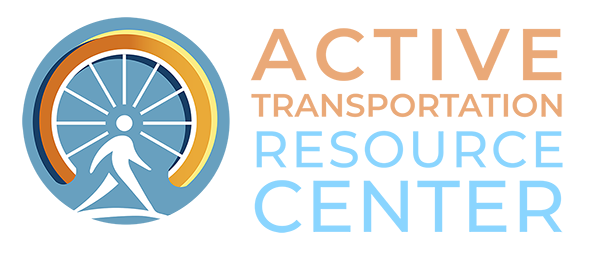Evaluation activities measure both program or project outputs (deliverables) and outcomes. Evaluation helps address whether a program is doing what it intended to do.
Evaluation involves data collection and analysis. The following tools and resources can be helpful for evaluation, as well as planning, prioritization, and project development.
Resources
Data Sources & Tools
Ongoing and updated data on bicycling and walking in the United States. Explore data on bicycling and walking and use that data to support your efforts to improve bicycling and walking.
A mapping tool that helps identify California communities that are most affected by many sources of pollution, and where people are often especially vulnerable to pollution’s effects. CalEnviroScreen uses environmental, health, and socioeconomic information to produce scores for every census tract in the state. The scores are mapped so that different communities can be compared. An area with a high score is one that experiences a much higher pollution burden than areas with low scores.
A tool to estimate expected benefits of proposed active transportation projects. It helps government agencies, practitioners, and community members understand project-specific cost effectiveness and explore options for improving project design.
HPI maps data on social conditions that drive health — like education, job opportunities, clean air and water, and other indicators that are positively associated with life expectancy at birth. Community leaders, policymakers, academics, and other stakeholders use the HPI to compare the health and well-being of communities, identify health inequities and quantify the factors that shape health. HPI includes a composite score for each census tract in the State based on 25 community characteristics. The scores are then converted to a percentile to compare it to other tracts in the State.
A series of tools to visualize crash data and traffic safety activities in conjunction with demographics in California. The Traffic Safety and Equity Overview Tool consists of a series of dashboards that allow users to access both detailed crash and demographic information on the region of choice while also ranking different geographic regions by various fatality and serious injury metrics. The Safety Heat Map allows for a more detailed analysis by creating interactive heat maps utilizing crash and demographic data as well as traffic safety improvement activities in California. Finally, the OTS Grants Clearinghouse serves as a platform where California Office of Traffic Safety (OTS) officials and grantees can access historical grant data.
The Transportation Equity Index (EQI) is a spatial screening tool designed to identify transportation-based priority populations at the Census block level. The EQI integrates transportation and socioeconomic indicators into three screens: Transportation-Based Priority Populations, Traffic Exposure, and Access to Destinations.
An interactive mapping tool that uses datasets that are indicators of burdens in eight categories: climate change, energy, health, housing, legacy pollution, transportation, water and wastewater, and workforce development. Note: This is Version 2 of the Climate and Economic Justice Screening Tool, released by the Council on Environmental Quality in December 2024. Although the tool remains unchanged, public access through the White House was discontinued on January 22, 2025. The Public Environmental Data Partners re-created Version 2 and made it publicly accessible.
Information on eligibility for free or reduced-price meals under the National School Lunch Program.
The Guidebook for Measuring Multimodal Network Connectivity is a guide for transportation planners and analysts on applying analysis methods and measures to support transportation planning and programming decisions. It describes a five-step analysis process and numerous methods and measures to support a variety of planning decisions. It includes references and illustrations of current practices, including materials from five case studies conducted as part of the research process.
This website provides data about the health and well-being of children in communities across California.
This fact sheet describes common evaluation activities for active transportation projects.
The PBIC has compiled key facts and figures related to active transportation and safety, the economy, the environment, health, and equity.
Health data for small areas across the country. PLACES allows local health departments and jurisdictions, regardless of population size and rurality, to better understand the burden and geographic distribution of health measures in their areas and assist them in planning public health interventions. PLACES provides model-based, population-level analysis and community estimates of health measures to all counties, places (incorporated and census designated places), census tracts, and ZIP Code Tabulation Areas (ZCTAs) across the United States.
The Recreational Bicycling Access Tool, developed by PeopleForBikes in partnership with REI and Axis Maps, evaluates the accessibility, quality, and connectivity of recreational biking facilities across the United States using data from OpenStreetMap and the U.S. Census. The tool provides comprehensive data to guide investments in recreational bicycling facilities, ensuring every community has the tools to build better, more connected bike networks that meet the needs of riders of all ages and abilities.
A community engagement tool that allows residents, community groups and agencies to collect information about transportation crashes, near-misses, general hazards and safe locations to travel.
The Transportation Injury Mapping System (TIMS) has been developed over the past ten-plus years by SafeTREC to provide quick, easy and free access to California crash data, the Statewide Integrated Traffic Records System (SWITRS), that has been geo-coded by SafeTREC to make it easy to map crashes.
Provides information on Median Household Income that can be used in ATP applications.
General Evaluation
The Guidebook for Measuring Multimodal Network Connectivity is a guide for transportation planners and analysts on applying analysis methods and measures to support transportation planning and programming decisions. It describes a five-step analysis process and numerous methods and measures to support a variety of planning decisions. It includes references and illustrations of current practices, including materials from five case studies conducted as part of the research process.
This fact sheet describes common evaluation activities for active transportation projects.


